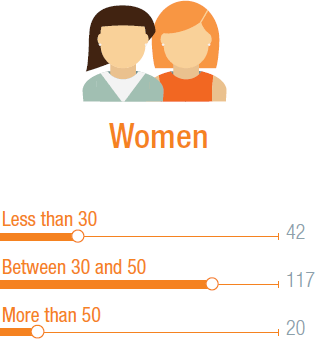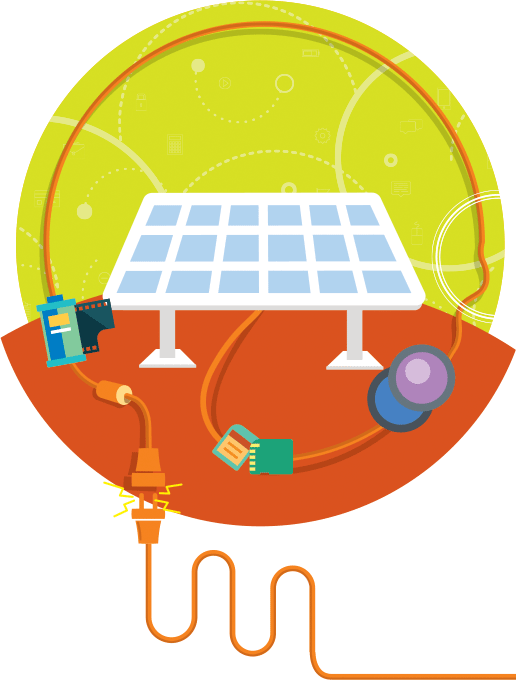Approach to and frequency of stakeholder engagement
GRI G4-26
| Approach to stakeholder engagement |
Frequency of engagement |
Stakeholder groups |
| Public hearings |
When prospects are for the construction of a new project. |
Surrounding community, environmental and social entities and direct partners in the project |
| Materiality Matrix |
Biannual preparation and annual updating, including part of the process for producing the Sustainability Report |
All |
| Website |
Constant |
All. The organization’s approach to stakeholder engagement is divided as follows: communication consultancy, attending clients, attending the community, investors, energy trading, Ethics Committee, environment, occupational safety and medicine, research and development and recommendations for shareholders’ meetings |
| Environment Week |
Annual |
Employees (own and outsourced), suppliers, local community, socio-environmental organizations and the surrounding community |
| Ethics, Sustainability and Energy Seminar |
Annual |
Employees (direct and indirect), suppliers, local community, socio-environmental organizations and the surrounding community. |
| Internal Occupational Accident Prevention Week (Sipat) |
Annual |
Employees (own and outsourced) and suppliers |
| Plant Visits Program |
Constant |
Surrounding community, suppliers, clients, investors, academia and primary education institutions |
The Company also contributes to the development of the electricity sector as a whole and the communities situated in its concession areas through the participation of employees and/or directors in entities, associations and forums related to certain aspects or relevant issues. In 2015, Tractebel Energia participated in the following bodies: GRI G4-16
- Brazilian Association for Electric Energy Generating Companies (Abrage).
- Brazilian Mineral Coal Association (ABCM).
- Brazilian Association of Risk Management (ABGR).
- Brazilian Maintenance Association (Abraman).
- Brazilian Energy Traders Association (Abracel).
- Brazilian Association of Electric Energy Industry Accountants – (Abraconee).
- Brazilian Association of Independent Power Producers (Apine).
- Capivari de Baixo Commercial and Industrial Association (Acicap).
- Florianópolis Commercial and Industrial Association (Acif).
- Lages Commercial and Industrial Association (Acil).
- Tuberão Commercial and Industrial Association (Acit).
- Healthcare Association (Elosaúde).
- Santa Catarina Association of Telecommunications and Information Technology Users (Sucesu).
- Energy Co-Generation Industry of São Paulo (Cogen).
- Apuaê-Inhadava Hydrographic Basin.
- Electric Energy Trade Board (CCEE).
- Electric Energy Research Center (Cepel).
- Canoas River Basin Committee.
- Tubarão River Hydrographic Basin and Lagunar System Committee.
- State of Rio Grande do Sul Energy Planning Committee (Copergs).
- Council for Development of the Cantuquiriguaçu Territory (Condetec).
- National Water Resources Council (CNRH).
- Santa Catarina State Water Resources Council for Santa Catarina (CERH-SC).
- Paraná State Water Resources Council (CERH-PR).
- Environment Council of the National Confederation of Industry (CNI).
- Industries Federation of the State of Santa Catarina (Fiesc).
- Confederation and Center of Industries for the State of Rio Grande do Sul (Fiergs).
- Business Management Foundation Committee (Funcoge).
- Eletrosul Social Security Foundation (Elos).
- Santa Catarina Leaders Group (LIDE-SC).
- Acende Brasil Institute.
- Brazilian Investor Relations Institute (Ibri).
- Internal Auditors of Brazil Institute (Audibra).
- International Hydropower Association (IHA).
- National Electric System Operator (ONS).
- Society for Complementary Social Security (Previg).
- World Energy Council – Brazilian Committee of the World Energy Council (CBCME).
Tractebel Energia also adheres to the United Nations Organization’s Millennium Development Goals (MDGs) – which in 2016 were redenominated the Sustainable Development Goals (SDGs) –, through the Santa Catarina We Can Movement, of which it is also a supporter. Indirectly through ENGIE, the Company is signatory to the Carbon Disclosure Program (CDP) and the United Nations Global Compact. In December 2015, Tractebel Energia ratified its agreement with the Brazilian Business Pact for Integrity and Against Corruption, to which it had acceded in 2011. All are voluntary initiatives. GRI G4-15
Employees
GRI G4-DMA (Employee)
The core objective underlying Tractebel Energia’s Human Resources guidelines is strengthening management by results. This is sustained by the quest for a responsible, fair and ethical working environment which provides quality of life and satisfaction to the employees, ensuring the right conditions for performance, development and recognition. In this context, the Company offers its employees one of the most comprehensive benefits plans in the sector. The plan includes life insurance (with cover for total or partial permanent incapacity due to accident or disease); health insurance plan (encompassing assistance for medical/hospital, odontological and drugstore expenses); psycho-therapy, physiotherapy and specialized reeducation treatment; eye glasses and ophthalmological lenses; hearing aids and orthopedic aids); help in the event of handicap and incapacity (for family members there is a Specialized Personal Support Program); extended maternity leave as well as paternity leave; plan for the acquisition of shares in the parent company; and food/meal coupons and transportation vouchers. In addition, Tractebel Energia subsidizes 80% of the value of prescription drugs for employees and their family members, 60% of the cost of language courses and 50% for school graduation tuition. Employees are also guaranteed freedom of association. In 2015, 100% were covered by collective bargaining agreements. GRI G4-LA2 G4-11
The Company is conscious of the importance of helping its employees to prepare for the end of their working lives, offering them a complementary pension plan and depositing 50% of the contribution to the corporate Complementary Pension Fund (Previg). During 2015, Tractebel Energia paid in R$20.4 million to the fund, which at the end of the year had a membership of 1,786 between employees and ex-employees. Tractebel Energia is also a sponsor of the Fundação Eletrosul de Previdência e Assistência Social (ELOS) complementary pension plan since some of its ex-employee retirees are members. In 2015, the Company’s contribution to ELOS was R$3.2 million. GRI G4-EC3
As at December 31, 2015, 76 employees were already retirees under the state pension scheme although continuing to work at Tractebel Energia. A further 38% were entitled to take state pension in the next five years and 6% within ten years. The Company has implemented a plan for succession and filling new positions to manage the transition process. In 2013, it relaunched a Voluntary Severance Plan (PDV), prioritizing those employees who had already qualified for the state retirement pension or were entitled to do so by 2016. The plan is entirely optional and is also designed to provide information and reflection on the new post-retirement routine, also covering the legal, emotional and healthcare aspects. The plan is divided into three stages: preparation for retirement, post-retirement and initiatives for continuing to maintain a bond with the Company. GRI G4-LA10
The Human Resources programs for the development and retention of talent are mentioned under the Intangible Assets item.
EVERY TWO YEARS, THE COMPANY UNDERTAKES AN ORGANIZATIONAL CLIMATE SURVEY, THE MOST RECENT BEING IN 2014, WITH THE PARTICIPATION OF 76% OF THE EMPLOYEES, RECORDING A SATISFACTION RATE OF 74%
Employee profile
At the end of 2015, Tractebel Energia had a payroll of 1,135 (84.2% male and 15.8% female). A total of 1,124 has permanent labor contracts, two with contracts for a specific period and nine with apprentices’ contracts (the Young Apprentice program). There are also an additional 1,023 outsourced employees. GRI G4-10
At the close of the period under review, Companhia Energética Estreito S.A. had 26 employees, Itá Energética S.A., a further seven contracted personnel while Usina Termoelétrica Pampa Sul S.A. employed 28 professionals.
Tractebel Energia’s payroll profile in 2015
GRI G4-10
| Category |
Men |
Women |
Total |
| Managerial |
101 |
15 |
117 (10.3% of the total) |
| Analysts, engineers and specialists |
320 |
86 |
406 (35% of the total) |
| Operators, maintenance technicians and administrative staff |
535 |
77 |
612 (53.9% of the total) |
Tractebel Energia’s payroll in 2015 by region
GRI G4-10
| State |
Number of employees |
Percentage in relation to total payroll numbers (%) |
| Santa Catarina |
742 |
65.4 |
| Rio Grande do Sul |
171 |
15.1 |
| Paraná |
105 |
9.3 |
| Maranhão |
53 |
4.7 |
| Goiás |
21 |
1.9 |
| Tocantins |
14 |
1.2 |
| Ceará |
9 |
0.8 |
| Mato Grosso do Sul |
8 |
0.7 |
| Mato Grosso |
5 |
0.4 |
| São Paulo |
4 |
0.4 |
| Minas Gerais |
2 |
0.2 |
| Piauí |
1 |
0.1 |
Tractebel Energia’s payroll in 2015 by gender and age group GRI G4-LA1
New hires in 2015 by gender and age group
GRI G4-LA1
| Age group |
Men |
Women |
| Less than 30 |
17 |
14 |
| Between 30 and 50 |
11 |
6 |
| More than 50 |
- |
- |
Terminations in 2015 by gender and age group
GRI G4-LA1
| Age group |
Men |
Women |
| Less than 30 |
7 |
4 |
| Between 30 and 50 |
13 |
3 |
| More than 50 |
15 |
3 |
Average time of service at Tractebel Energia of employees terminated in 2015
GRI G4-LA1
| Gender/age group |
Numbers |
Average time of service (years) |
| Women |
10 |
9.1 |
| Less than 30 |
4 |
0.0 |
| Between 30 and 50 |
3 |
3.0 |
| More than 50 |
3 |
27.3 |
| Men |
35 |
18.0 |
| Less than 30 |
7 |
0.6 |
| Between 30 and 50 |
15 |
13.2 |
| More than 50 |
13 |
30.3 |
| Total |
45 |
16.0 |
| Gender/age group |
Terminations |
Numbers |
Turnover rate (%) |
| Women |
10 |
179 |
5.6 |
| Less than 30 |
4 |
42 |
9.5 |
| Between 30 and 50 |
3 |
20 |
15.0 |
| More than 50 |
3 |
117 |
2.6 |
| Men |
35 |
956 |
3.7 |
| Less than 30 |
7 |
174 |
4.0 |
| Between 30 and 50 |
15 |
241 |
6.2 |
| More than 50 |
13 |
541 |
2.4 |
| Total |
45 |
1,135 |
4.0 |
Occupational Health and Safety (OHS)
GRI G4-DMA (Occupational health and safety)
The physical and psychic integrity, professionalism, skills and competency of the employees are Company priorities. In this context, Occupational Health and Safety (OHS) is one of the five pillars supporting Tractebel Energia’s Policy of Sustainable Management. All agreements with service providers carry clauses with respect to the theme to ensure that occupational health and safety is guaranteed in full.
With this objective in focus, the Company ran two key campaigns during the year: “Less Consumption, More Sustainability” – to promote and increase employee awareness on the consumption of natural resources, both in and outside the company. The second, “The Ten Rules that Save Lives”, involved both direct employees and outsourced personnel with a detailed presentation on the appropriate behavior and actions to be taken (or avoided) in the event of risk scenarios. Thanks to these and other OHS-related initiatives such as the permanent installation of formal occupational health and safety committees together with the Internal Accident Prevention Commissions (Cipas) – which totaled 131 members in 2015, representing all the areas of Tractebel – no accidents were recorded requiring time off work among direct employees during the year. The targets for Frequency Rate (Taxa de Frequência – TF) and Severity Rate (Taxa de Gravidade – TG) of less than 2.2 and 0.052, respectively, were achieved. The goal of avoiding all fatal accidents on the Company’s premises was also achieved as shown in the following table. GRI G4-LA5
Accidents reported in 2015
GRI G4-LA6
| With direct employees |
| Number of hours of exposure to hazards |
2,094 |
| Number of occupational or commuting accidents with and without time off work |
8 |
| Number of lost days – occupational accidents |
0 |
| Number of fatal accidents |
0 |
| With employees from contracted companies |
| Number of hours of exposure to hazards |
3,502,115 |
| Number of occupational or commuting accidents with and without time off work |
28 |
| Number of lost days – occupational accidents with time off work |
3 |
| Number lost days – occupational accidents |
22 |
| Number of fatal accidents |
0 |
| Frequency Rate (TF) |
0.86 |
| Severity Rate (TG) |
0.000 |

0.000 WAS TRACTEBEL ENERGIA’S SEVERITY RATE (TG) FOR ACCIDENTS INCLUDING OUTSOURCED EMPLOYEES IN FISCAL YEAR 2015
| |
2013 |
2014 |
2015 |
Target 2015 |
| Frequency Rate (TF), excluding outsourced positions1 |
0.980 |
1.450 |
0.000 |
|
| Severity Rate (TG), excluding outsourced positions2 |
0.000 |
0.062 |
0.000 |
<0.052 |
| Frequency Rate (TF), including outsourced positions1 |
0.950 |
2.870 |
0.540 |
<2.20 |
| Severity Rate (TG), including outsourced positions2 |
0.006 |
0.023 |
0.000 |
|
1. TF = Number of occupational accidents for every million hours of exposure to hazards.
2. TG = Number of days lost due to occupational accidents for every one thousand hours of exposure to hazards. |
Of the collective bargaining agreements between Tractebel Energia and the labor unions, 90% include specific clauses on OHS issues, in particular training and education for first responders and members of Cipas. The agreements are nationally binding (between the Company and the labor unions for each region of the country where Tractebel Energia operates). The parent company, ENGIE is not involved in any agreement. The Company requires that annual refresher training be given to the teams of first responders to ensure that they are fully equiped to give first aid in the event of personal accidents in the Company’s installations. GRI G4-LA8
Clients
GRI G4-DMA (Products and services labelling)
Tractebel Energia’s relationship with its clients, be they in the regulated or the free environment market, is one of mutual trust and creation of value. In this context, to foster the rational use of electricity is one of the Company’s commitments in its Policy on Climate Change. This Policy is validated in the Energy Efficiency Program which is offered to industrial clients with information on how to rationalize the use of energy and eliminate or minimize eventual environmental impacts.
Tractebel Energia does not serve residential consumers directly. At the end of 2015, its commercial portfolio consisted of 228 clients, drawn from industrial, commercial and services sectors and corresponding to about 460 consumer units. Conducted on a biannual basis, no formal consumer satisfaction surveys were conducted in 2015. On the occasion of the last survey in 2014, the Company registered a favorability ratio of 94.8% (either satisfied or very satisfied). The previous survey in 2012 had reported a favorability index of 94.5%. GRI G4-EU3
Within the scope of the Client Relationship Program, which encapsulates its commercial policy and focus on sustainable development, in 2004, the Company launched the Tractebel Energia Energy Efficiency Diagnosis Program. The Program is offered free of charge to unregulated market consumers as a means of identifying possibilities for reducing the consumption of energy and for presenting alternatives for optimizing its use. The Company uses a methodology of conducting interviews, data collection, measurements, analyses and studies of the consumer’s installations and operations in addition to assessing external information, references, software, etc. In 2015, Tractebel Energia conducted energy efficiency diagnoses at three clients, identifying savings totaling 40,447 MWh in consumption. The Electric Energy Diagnosis Report pinpoints the areas where there is potential for implementing rationalized and conscious energy consumption. The implementation of suggested improvements is the exclusive option of the Program’s beneficiaries.
GRI G4-DMA (formerly EU7)
THE COMPANY ADOPTS A ROLE AS CATALYST FOR CONCEPTS OF SUSTAINABLE DEVELOPMENT AND SEEKS CONTINUAL IMPROVEMENT IN STAKEHOLDER RELATIONS
Suppliers
GRI G4-12 G4-DMA (Supplier assessment for labor practices)
Tractebel Energia’s value chain is made up of thousands of suppliers of goods and services in different regions of Brazil and overseas. The Company adopts the role of a catalyst for propagating the concepts of sustainable development. In the light of this approach, it seeks continual improvement in the relationship with its suppliers, focused on engagement and commitment with human rights, social responsibility, occupational health and safety and the environment. In the case of small and middle market companies heavily dependent on the Company for their revenues, support is given to marketing and economic-financial management to eliminate any eventual dependence.
Tractebel Energia also adopts procedures which are governed by administrative standards for selecting offers necessary to meet its interests at the best cost-benefit ratio and on an acceptable basis for both parties. In addition, outsourced employees enjoy a permanent benefits program which includes health and dental care plans, the values of which are built into employment agreements.
The Company adopts a specific procedure of constant supplier evaluation. In addition to the examination of legal and technical documentation prior to signature of an agreement, Tractebel Energia conducts evaluations of performance during the execution of certain services. The evaluations are annual should the agreement period be more than 12 months. Where agreements are for a lesser period, assessments are made on the conclusion of the service.
This assessment incorporates aspects such as quality of the services, safety, occupational medicine and hygiene, the environment and administrative and legal issues. Should the supplier’s score be less than the minimum of 70% – and should the supplier show non-compliance during the course of the execution of the agreement –, Tractebel Energia will request the supplier to address the issues with remedial plans.
In 2015, 27 suppliers reported non-compliance with labor practices, particularly in the area of occupational health and safety, poor standards of hygiene and excessive working hours. In accordance with its management procedures, Tractebel Energia agreed several points for adjustment and improvement with all parties in this group, in no case contractual rescission being required. These suppliers represented 1.34% out of a total of 2,008 active suppliers to the Company at the end of 2015. GRI G4-LA15
In addition, priority is given to hiring local suppliers and local procurement as part of the strategic focus on sustainability. For example, in 2015, 62% of all suppliers were engaged locally, that is 1,236 companies out of a total of 2,008 commercial partners. Coal is a case in point. This resource is the principal raw material of the thermal power plants located in southern Brazil and virtually all the Company’s needs are acquired locally. In 2015, R$3.44 billion was paid out to local suppliers in relation to an aggregate amount of R$3.8 billion, equivalent to 90.48% of the total amount expended on coal supplies. GRI G4-EC9 G4-DMA (Procurement practices)
Communities
GRI G4-SO1 G4-DMA (Local communities)
Tractebel Energia endeavors to permanently expand the dialog with the community and contribute to local sustainable development in the regions contiguous to its head office and plants. To this end, the Company develops programs for community engagement at all its operations around the country. It also seeks to maintain ethical and transparent relations, develop partnerships with local entities – such as universities and the third sector organizations –, at the same time, prioritizing the engagement and training of professionals and suppliers domiciled in the region in which it conducts its activities.
In addition, all projects where installed capacity is to be expanded are preceded by an assessment of social and environmental impacts. These are monitored on a permanent basis through programs which begin at the construction phase, often being continued once the plant is fully operational. In these cases, the results of socio-environmental assessments are disclosed through the medium of public hearings as called for under current Brazilian legislation. A case in point was the public hearing held in the city of Garuva (SC) in 2015 on the construction of the Norte Catarinense Thermoelectric Power Plant, one of the Company´s projects at the evaluation and licensing stage. Throughout the year, Tractebel Energia also continued to implement several programs and actions for improving the quality of life in the community surrounding the Santa Mônica Wind Complex in the state of Ceará. Such programs and actions include:
- Drilling, opening and donating artesian wells for the communities located in the areas directly affected by the Complex;
- Pedagogic projects which benefit the communities and the public school network, most notably, the installation of a botanic nursery garden;
- Signature of an agreement with Trairi City Government and the ENGIE Foundation for the implementation of the “Healthy Children, Healthy Future” program designed by the NGO, INMED for promoting nutritional education for children of school age in the community through preventive actions in the areas of healthcare, nutrition and hygiene; and
- Introduction of a 0800 number for handling external demands from the public, thus creating a further communication channel and direct line of contact with the community.
In the case of the Pampa Sul Thermoelectric Power Plant in the state of Rio Grande do Sul, Tractebel Energia has maintained a series of socio-environmental measures such as programs for hiring and training local labor, social communication, environmental education and replanting riparian margins and the connecting ecological corridor.
One of the leading relationship initiatives with the communities in which the Company operates is the Sustainability and Culture Centers. Installed with the support of Tractebel Energia since 2011, these make a significant contribution to the sustainable development of small municipalities. The principal aims of these centers are:
- To stimulate an enhanced appreciation of local customs and traditions in the communities in which Tractebel Energia operates;
- To provoke the search for knowledge through social and digital inclusion among young people, contributing to the creation of employment, income and a reduction in rural and urban depopulation from the areas within the sphere of influence of the plants;
- To provide various spaces for community confraternization for all and any kind of cultural expression such as the performing and plastic arts, dance performances, musical shows and movie exhibitions; and
- To make the Sustainability and Culture Centers economically sustainable entities with a structured program for generating income and ensuring that costs are controlled.
At the end of 2015, four centers were operating: Entre Rios do Sul Culture Center (SC), Alto Bela Vista Culture Center (SC), Capivari de Baixo Sustainability and Culture Center (SC) and the Quedas do Iguaçu Culture Center (PR).
Numbers – Sustainability and Culture Centers in 2015
| Center |
Different workshops / classes offered |
Enrolled students |
Performances/events held by the community |
Estimated audience at the performances / events |
| Entre Rios do Sul |
15 |
318 |
5 |
7,000 |
| Alto Bela Vista |
13 |
216 |
15 |
10,000 |
| Capivari de Baixo |
5 |
159 |
122 |
27,000 |
| Quedas do Iguaçu |
6 |
153 |
64 |
15,000 |
In 2016, the Concórdia Culture Center (SC) is to be opened in partnership with Concórdia city government and in 2017, the Centers in Minaçu (GO), Trairi (CE), Itá (SC) and Saudade do Iguaçu (PR) are to be unveiled.
The Plant Visiting Program is another important medium for community engagement. In partnership with other entities, the Company runs guided tours for students, researchers and tourists around the plants in its generator complex. Visitors are shown plant operations as well as the socio-environmental programs Tractebel Energia offers. Complementary to this program are presentations made in schools and other community spaces, the emphasis being on environmental education. In 2015, a total of 100,464 took part in this program.
Tractebel Energia provides a system whereby Sustainability Committee members are able to evaluate proposals for sustainable development in the regions of the plants and head office. Known as “Sustainability Projects, Actions and Goals Manager” (GAS), the system also permits budgetary control of approved initiatives, irrespective of whether these are proposed by third parties or directly implemented under Tractebel Energia’s Social Responsibility Programs for cultural development, social inclusion and environmental improvement. Following continuous fine tuning since inception in 2010, GAS was one of the 2015 award winners in the Tractebel Energia innovation incentive program, Inove.
The Company sets annual goals and actions under its Social Responsibility Programs – Cultural Development, Environmental Improvement and Social Inclusion –, as well as the Education Program for Sustainability. The principal initiatives taken to achieve the goals set out in these programs have been mentioned during the course of this Report. Other highlights are shown as follows:
- Realization of the IV Ethics, Sustainability and Energy Seminar with simultaneous presentations at the head office and the Salto Santiago Hydroelectric Power Plant, with transmission via video link to other plants. The Seminar’s theme was water management.
- Realization of Sustainability and Environment Weeks in areas surrounding the Jorge Lacerda Thermoelectric Complex in the state of Santa Catarina and the Salto Santiago and Salto Osório hydroelectric power plants in the state of Paraná.
- Realization of the Voluntary Energy Social Gymkhana. This initiative involved employees from all Tractebel Energia’s plants and organizational units with the donation of toys, items of personal hygiene, apparel and foodstuffs to philanthropic institutions. Each product carries a pre-established score, the winning teams being able to select the final destination of the donations. In all, the gymkhana received donations of 27,783 items from 883 volunteers (77.8% of the employee payroll).
- Maintenance of the revitalization project at the Vila Vermelho settlement in the municipalityh of Cavalcante (GO) near the Cana Brava Hydroelectric Plant, including repairs to the school, originally donated by the Company in 2004.
- Ongoing work on the installation of new Culture Centers and the Headwaters Conservation Program.
During the course of the year, the Company invested R$15.3 million in socially responsible initiatives, of which 21.5% corresponded to own resources and 78.4% to incentivized funding as shown in the following table.
Social responsibility indicators (R$ thousand)
| |
2013 |
2014 |
2015 |
Change 2015/2014 (%) |
| Non-incentivized social projects |
3,270.12 |
4,354.28 |
3,304.36 |
-31.77 |
| Incentivized social projects via the Children and Adolescents Fund |
2,079.50 |
1,887.43 |
1,780.91 |
-5.98 |
| Incentivized social projects under the sport incentive laws |
360.00 |
1,319.04 |
1,320.00 |
0.07 |
| Incentivized cultural projects under the Rouanet Law |
10,282.24 |
9,396.10 |
7,583.44 |
-23.90 |
| Incentivized social projects under the healthcare incentive laws |
- |
1,220.60 |
1,187.77 |
-2.76 |
| Incentivized social projects under the Municipal Fund for the Elderly |
- |
- |
142.04 |
- |
| Total |
15,991.86 |
18,177.45 |
15,318.52 |
-18.66 |
THE COMPANY’S SUSTAINABILITY COMMITTEE IS RESPONSIBLE FOR EVALUATING SUSTAINABLE DEVELOPMENT ACTIONS, CONTRIBUTING TO THE EFFICACY OF THE INITIATIVES
Municipalities and states where reservoirs associated to hydroelectric plants are located, received R$180.3 million in royalties – Financial Compensation for Use of Water Resources – CFURH (Compensação Financeira pela Utilização de Recursos Hídricos). The legislation requires that funds be apportioned in equal tranches of 45% to the municipalities and states, while the federal government receives the remaining 10%. The percentage of flooded area in each municipal district is the criterion used for prorating the proceeds to the various government beneficiaries. In 2015, the Company paid out royalties to eight states and 65 municipalities as direct beneficiaries of the CFURH.
Another key economic impact on the communities arising from the Company´s activities is the leasing of areas for installation of wind plants. The areas on which these operations are installed together with surrounding land do not belong to the Company. Rather, these areas are leased from their owners, the latter receiving normally 0.5% of the net revenue of the project. Consequently, direct and indirect income is generated and circulates in the surrounding region among landowners, traders and the local economy as a whole, driving the growth of the municipalities and states as a result of the increased revenue. In 2015, Tractebel Energia paid out R$2.8 million on 52 leasing agreements.














